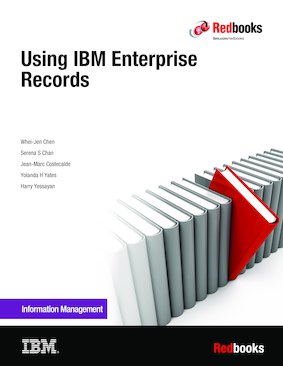About cookies on this site Our websites require some cookies to function properly (required). In addition, other cookies may be used with your consent to analyze site usage, improve the user experience and for advertising. For more information, please review your options. By visiting our website, you agree to our processing of information as described in IBM’sprivacy statement. To provide a smooth navigation, your cookie preferences will be shared across the IBM web domains listed here.

Published on 29 May 2015
Read in Google Books Order hardcopy
Share this page:
ISBN-10: 073844071X
ISBN-13: 9780738440712
IBM Form #: SG24-7623-01
Authors: Whei-Jen Chen, Serena S Chan, Jean-Marc Costecalde, Yolanda H Yates and Harry Yessayan
Abstract
Records management helps users address evolving governance mandates to meet regulatory, legal, and fiduciary requirements. Proactive adherence to information retention policies and procedures is a critical facet of any compliance strategy. IBM® Enterprise Records helps organizations enforce centralized policy management for file plans, retention schedules, legal preservation holds, and auditing. IBM Enterprise Records enables your organization to securely capture, declare, classify, store, and dispose of electronic and physical records.
In this IBM Redbooks® publication, we introduce the records management concept and provide an overview of IBM Enterprise Records. We address records management topics, including the retention schedule, file plan, records ingestion and declaration, records disposition, records hold, and Enterprise Records application programming interfaces (APIs). We also use a case study to describe step-by-step instructions to implement a sample records management solution using Enterprise Records. We provide concrete examples of how to perform tasks, such as file plan creation, records ingestion and declaration, records disposition, and records hold.
This book helps you to understand the records management concept, the IBM Enterprise Records features and capabilities, and its use.
Table of Contents
Part 1. Concept
Chapter 1. Records management
Chapter 2. IBM Enterprise Records system and architecture
Chapter 3. Retention and file plans
Chapter 4. Security
Chapter 5. Records capture, creation, and retrieval
Chapter 6. Records disposition and basic schedules
Chapter 7. Advanced disposition
Chapter 8. Holds and preservation
Chapter 9. Audit requirements
Chapter 10. Reporting
Chapter 11. Physical records
Chapter 12. IBM Enterprise Records Java APIs
Chapter 13. IBM Enterprise Records for IBM Content Manager
Part 2. Implementation case studies
Chapter 14. File plan case study
Chapter 15. Basic disposition case study
Chapter 16. Advanced disposition case study
Chapter 17. Records hold case study
Chapter 18. IBM Java API for Records Manager case study